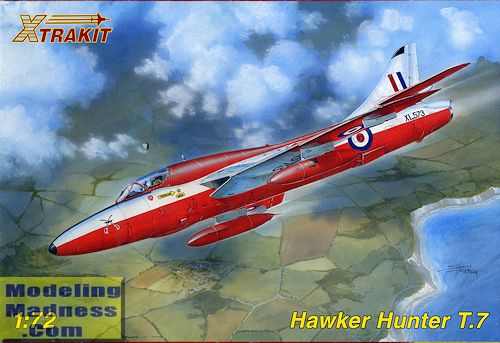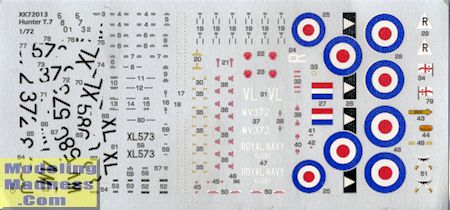
| KIT #: | XK 72013 |
| PRICE: | £15.42 plus about £5.50 shipping (I ordered two and that is about half the shipping price). |
| DECALS: | Three options |
| REVIEWER: | Scott Van Aken |
| NOTES: |

| HISTORY |
The Hawker Hunter is a subsonic British jet aircraft developed in the 1950s. The single-seat Hunter entered service as a maneuverable fighter aircraft, and later operated in fighter-bomber and reconnaissance roles in numerous conflicts. Two-seat variants remained in use for training and secondary roles with the Royal Air Force (RAF) and Royal Navy until the early 1990s. The Hunter was also widely exported, serving with 21 other air forces. Fifty years after its original introduction it was still in active service, operated by the Lebanese Air Force until 2014.
On 7 September 1953, the modified first prototype broke the world air speed record, achieving 727.63 mph (1,171.01 km/h). Hunters were also used by two RAF display teams: the "Black Arrows", who on one occasion looped a record-breaking 22 examples in formation, and later the "Blue Diamonds", who flew 16 aircraft. Overall, 1,972 Hunters were produced by Hawker Siddeley and under licence. In British service, the aircraft was replaced by the English Electric Lightning, the Hawker Siddeley Harrier and the McDonnell Douglas Phantom.
The T.7 variant was a two-seat trainer built for the RAF. A side by side seating nose section replaced the single seat nose. Engine and systems as for the F.4; six were rebuilt F.4s, and 65 were new build. The dog-tooth leading edge and follow-up tailpane mods, as on the F.6, were fitted to the T.7. The T.7A was a T.7 modified with the Integrated Flight Instrumentation System (IFIS). Used by the RAF as a Blackburn Buccaneer conversion training aircraft. Just about every RAF Hunter squadron had at least one of these for refresher or conversion training.
| THE KIT |
 Xtrakit is a Hannant's brand and they have their kits produced by MPM. This means a quality short run kit with engraved panel lines, a photo etch fret and often some resin bits. In this case, the resin covers the two seats and the exhaust
Xtrakit is a Hannant's brand and they have their kits produced by MPM. This means a quality short run kit with engraved panel lines, a photo etch fret and often some resin bits. In this case, the resin covers the two seats and the exhaust , so nothing daunting. Photo etch is used for the main instrument panel, side consoles, front and rear of the main wheels, pull handles on the seats and windscreen wipers. I had wondered why no etched seat belts were included until I had a 'Homer' moment and realized this feature was already molded onto the resin seats.
, so nothing daunting. Photo etch is used for the main instrument panel, side consoles, front and rear of the main wheels, pull handles on the seats and windscreen wipers. I had wondered why no etched seat belts were included until I had a 'Homer' moment and realized this feature was already molded onto the resin seats.
The other two sprues fill the box and include the two fuselage halves, upper and lower wing sections, tailplanes, a pair of drop tanks and all the other bits required. There is wheel well detail in the upper wing halves and a separate nose gear well. I should mention that there is an acetate instrument sheet that fits behind the instrument panel. The cockcpit also has control sticks and rudder pedals.
Nose gear has a separate wheel, which I prefer over one molded in place. The main gear has separate oleo scissors and, as mentioned, the main wheel detail is photo etch as the plastic detailing is a bit bland. All of the gear doors are separate so no need to cut them apart. A tail hook and speed brake fit under the rear fuselage. The kit comes with clear plastic windscreen and canopy. Though not shown open, I think that one could easily pose the canopy in this position. There is a separate nose cap which will come in handy if the plane needs nose weight. None is indicated, but I would install some just in case.
 Instructions are well done and provide Xtracolor paint references as well as standard color names. A nice selection of color schemes are provided. First is the box art plane with 237 OCU in 1986/7. This was the Buccaneer training squadron. A Royal Navy T.8 in roundel blue over white is provided as is a standard camouflaged version with 2 Squadron in 1970. This plane has the high speed silver undersides, unlike later planes that used a light grey. The decals are superbly done and will be quite thin. THe lower wing serials are in sections already, making them easy to apply on the gear doors.
Instructions are well done and provide Xtracolor paint references as well as standard color names. A nice selection of color schemes are provided. First is the box art plane with 237 OCU in 1986/7. This was the Buccaneer training squadron. A Royal Navy T.8 in roundel blue over white is provided as is a standard camouflaged version with 2 Squadron in 1970. This plane has the high speed silver undersides, unlike later planes that used a light grey. The decals are superbly done and will be quite thin. THe lower wing serials are in sections already, making them easy to apply on the gear doors.
| CONCLUSIONS |
I have always liked the two seat Hunter. Many years back, I did a vac conversion to a Matchbox kit that I still display. I also have resin nose conversions for the Revell kit as well as some full resin kits. Where this one appeals is that there is not a lot of exotic material in it and that will cut the build time considerably, at least for me. Many think the Hunter is one of the more esthetic planes ever built and while the two seat nose has it lose a bit of that appeal, it is still a superb looking aircraft.
| REFERENCES |
http://en.wikipedia.org/wiki/Hawker_Hunter
May 2015 Thanks to me for the preview kit. If you would like your product reviewed fairly and fairly quickly, please contactthe editor or see other details in the